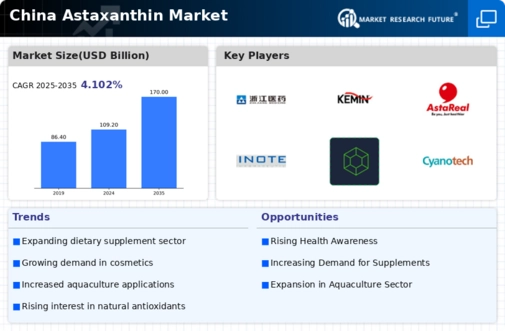The competitive insights of the China Astaxanthin Market reveal a dynamic landscape characterized by the rising demand for natural carotenoids, primarily driven by their health benefits and applications in dietary supplements, cosmetics, and aquaculture. As health consciousness among consumers continues to grow, companies in the astaxanthin sector are keen to innovate and expand their product lines to capture market share. The competition is shaped by several factors, including product quality, price competition, distribution networks, and branding strategies.
With increasing investments in R&D and collaborations between industry players, the market is poised for further growth, presenting both opportunities and challenges in the evolving regulatory environment and consumer preferences. Haematococcus pluvialis stands as a prominent player in the China Astaxanthin Market due to its exceptional capabilities in producing high-quality astaxanthin. This microalga is recognized for its natural production of astaxanthin, which is superior in potency and effectiveness compared to synthetic alternatives. The strengths of Haematococcus pluvialis primarily lie in its sustainable cultivation methods and ability to maintain a consistent quality of astaxanthin.
As a leading source of natural astaxanthin, this company's extensive research and development efforts have established its reputation, further enhancing its competitive edge in the growing market. The inherent advantages of Haematococcus pluvialis have enabled it to maintain a strong market presence, appealing to consumers and manufacturers seeking premium natural ingredients for their products. Zhejiang Medicine has carved out a significant niche in the China Astaxanthin Market through its diverse portfolio of health-related products, particularly in the area of dietary supplements and nutraceuticals.
The company's key offerings include various formulations rich in astaxanthin, catering to both consumer needs and industry standards. With a robust market presence, Zhejiang Medicine leverages its strong distribution channels and established relationships within the health and wellness sector. The company's strengths are further boosted by ongoing innovation in product development and strategic collaborations that enhance its competitive position. Recently, Zhejiang Medicine has been active in pursuing mergers and acquisitions to expand its capabilities and market reach, solidifying its footprint in the Chinese astaxanthin sector.
This proactive approach to growth and diversification has positioned the company favorably to meet the increasing demand for natural astaxanthin across different applications.







